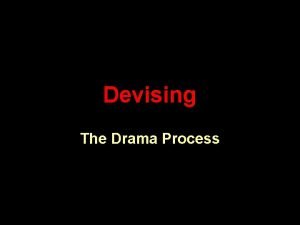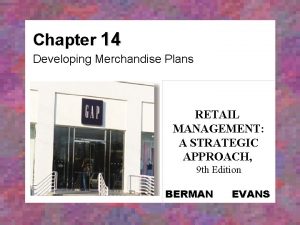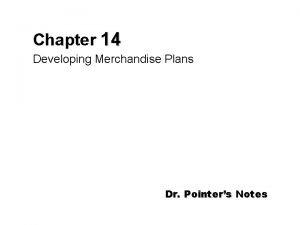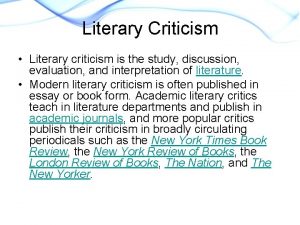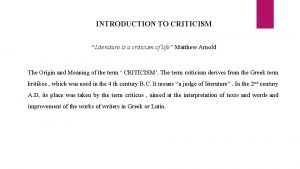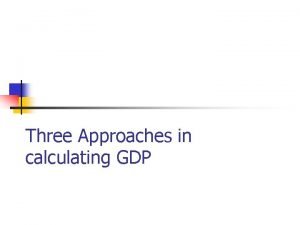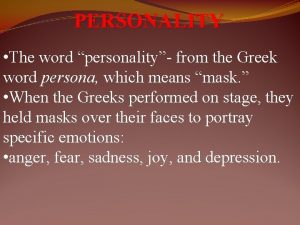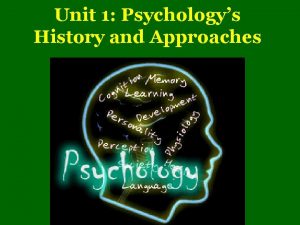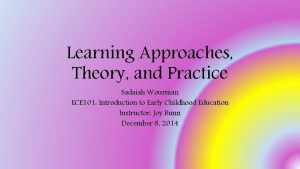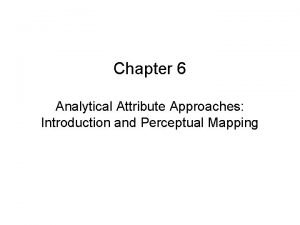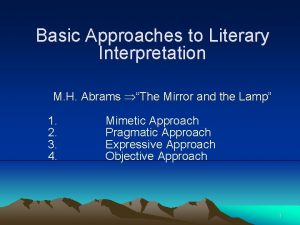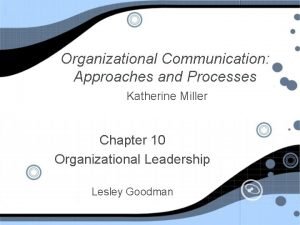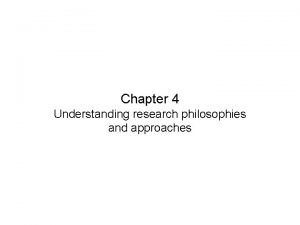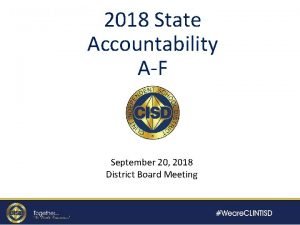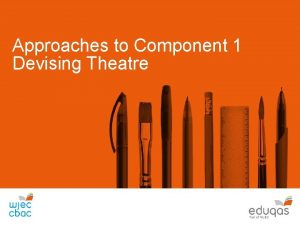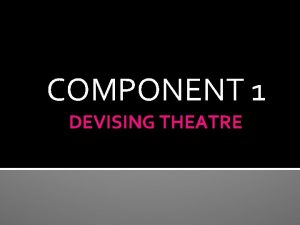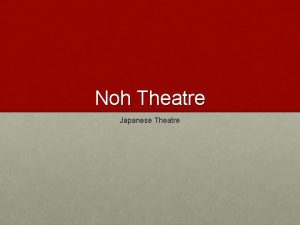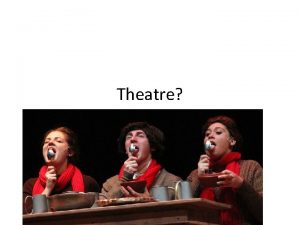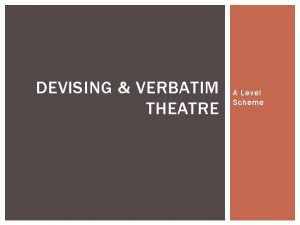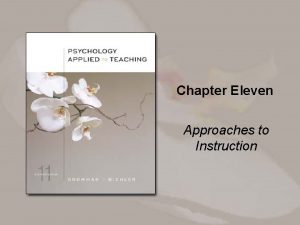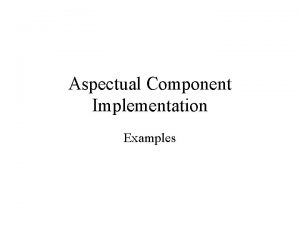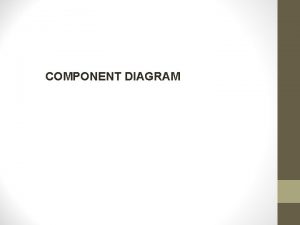Approaches to Component 1 Devising Theatre Component 1
































- Slides: 32

Approaches to Component 1 Devising Theatre

Component 1: Overview Internally assessed, externally moderated by WJEC Work submitted to WJEC by end of March (year 11) The centre can choose the date for the assessment Learners: • create develop and perform a piece using the techniques of a theatre practitioner/characteristics of a genre of their own choice • use a stimulus supplied by WJEC from a choice of four Groups should consist of between 2 -5 acting candidates with up to 4 additional design candidates, each working on a different design skill. The performance should be between 5 -16 minutes, depending on the number of performers. Learners must: • realise their performance/design (centres must record the work) • produce a portfolio of supporting evidence (750 -900 words) • Evaluate their performances (supervised conditions – 1 hour 30 minutes).

Tips and Good Practice Step 1: Devising - Choosing a genre/practitioner • Ensure that each group chooses only one practitioner/genre. Do not allow them to mix and match a variety of practitioners/genres. • Ensure learners have a clear understanding of their chosen practitioner/genre. • Learners should choose between 4 -6 techniques which they feel reflect their understanding of the style and enhance their piece. • Take them to as many productions as possible which allow them to see the style in performance Suggested practitioners/genres Brecht, Boal, Physical Theatre, TIE, Emma Rice, Katie Mitchell.


Component 1 Stimuli Example stimuli set by WJEC: A quotation: ‘All men are created equal’ American Declaration of Independence Lyrics of a song: Handbags and Gladrags, Stereophonics A picture: Parsifal I, Anselm Kiefer A concept: The closed door

Practical Approaches to Component 1 How do I devise? • From the beginning of year ten give learners multiple opportunities to experiment and develop their understanding of devising using a range of styles and stimuli • After each unit of work, learners undertake a “mini devising project”. These are assessed using unit one criteria for performance. • Encourage learners to note key moments in the process

Practical Approaches to Component 1 The ‘Pick and Mix” approach Introduce learners to a range of dramatic devices which they can use in their work. Ø Flashbacks, cross cutting, mime, monologues, multi-role, thought-tracking, slow-motion, narrator, direct-address, choral speaking. Encourage learners to choose devices which are best suited to their chosen practitioner/genre.

Practical Approaches to Component 1 • Include a range of practical exercises that improve and refine performance skills e. g. learners write and perform own monologue to the class. This exercise helps to highlight vocal work and how gesture can be used effectively. • Use short extracts of scripts e. g. opening scene of Betrayal by Pinter to highlight how pauses and subtext are used effectively.

Practical Approaches to Component 1 Choosing a stimulus • Introduce them to the stimuli they will base their work on towards the end of year 10. • Learners spend one lesson devising a short performance on each of the stimuli to familiarise themselves with them and to begin thinking of how they could be developed. • Develop individual ideas over the summer holidays ready to share and brainstorm with group in September of year 11

Interpretation of Stimuli • Familiarise learners with the assessment criteria. Band 5: Ø Highly imaginative ideas are created and developed in response to the chosen stimulus to communicate meaning • In order to access marks within the 25 -30 mark boundary the interpretation of stimuli must be very imaginative. If this is the case within the process, the learners should be able to document it within the portfolio. • Encourage learners to “think outside the box” they can take theme in whichever direction they choose as long as they are clear what the link is. • Learners must keep records (notes, photos, spider-grams, sketches, etc) of these initial exploration stages, including avenues of research

To Script or Not to Script? • The final performance needs to be polished and a “highly effective application of performance/design skills” are required to achieve top band marks. • Therefore scripting the work is essential and should be a group effort. • This will help both performers and designers as the script becomes a good starting point for the initial rehearsals E. g. Each member of the group (including any technical candidates) is responsible for writing one scene. Through group discussions they should know exactly who and what should be in their scene. They are given one week to write the scene. As a group they make changes, top and tail beginning and ends of scenes. The script then evolves in subsequent rehearsals.

Structuring The Devised Performance • A recurring weakness with devised work is lack of structure e. g. too long, too short, lacking contrast between scenes. • More able learners will link the structure to their chosen style. Brecht-episodic; Stanislavski-3 unities; TIE episodic. • Introduce students to the traditional model for structuring a play; Exposition; Rising action; Climax; Falling action; Denouement. • Encourage learners to plot a graph so they can see where the dramatic highlights are and whether they are evenly spaced out. • Clothes line technique - Students write mood/content of scene in one sentence. Place scenes side by side.

Structuring The Devised Performance Questions learners should ask: • Would a change of mood benefit the piece? • Are the highlights too close together? • Is there a clear beginning, middle and end? • Would the piece benefit if it started at the end e. g. Blood brothers • Does the piece end with a highlight? • Is there an over-emphasis on one particular character? • Experiment with a variety of improvisations prior to the devised piece to highlight the importance of contrasting style. • Scenario: There is a terrible argument between two friends at a 16 th birthday party. The friend leaves the party and is badly beaten up on the way home. • Experiment with three highly dramatic scenes in row. Now try the same play but with a contrasting scene to split the action. • Which is most effective and why?

Rehearsal Process • We recommend between 5 -6 weeks rehearsal period although there is no time limit. • You must view the work at least three times during the rehearsal period. You can make general suggestions for improvement with regard to both the devising and the performing. You cannot direct the whole piece. • Encourage learners to refine and develop key areas throughout the process e. g. in one rehearsal concentrate on voice, in another movement and interaction, in the third structure, in the fourth character and role development. • Encourage learners to use the performance self evaluation sheet in pack.

Rehearsal Process • Learners should review their use of the practitioner/genre techniques and assess how effective they are in performance. • Experiment with different types of acting areas. Which type is best suited to the style? • Use space, props etc. that will be used in the final performance. • Ensure learners do not have numerous scene changes and blackouts. • Set a deadline for lines to be learnt by, ideally 3 weeks into rehearsal. • Set deadlines for completion of set and costume, so actors can rehearse with them and any amendments/refinements can be made

Rehearsal Process • Encourage learners to watch each others work and give constructive feedback, perhaps using the audience evaluation sheet in pack. Ask them to look at both the acting and the design elements, where applicable. • Design candidates work closely with the acting candidates throughout the rehearsal process. Their work should also illustrate their understanding of the practitioners’ methods. • Always have a dress rehearsal. • Encourage learners to record all stages of the process, using any means appropriate, in preparation for their supporting evidence portfolio.

Performance Exemplar Chosen Stimulus Shadows (2015 -16) Title Blindness Chosen Practitioner/Genre Brecht Features Gestus, placards, narration, visible backstage/costume changes, multi-roling, political message

The Portfolio of Supporting Evidence Learners keep a record of supporting evidence, compiled during the process. It should focus on three stages/moments where the practical work has changed or developed in any significant way and explain how: 1. ideas have been researched, created and developed in response to the chosen stimulus 2. ideas from the chosen practitioner/genre have been incorporated in the piece to communicate meaning 3. ideas have been developed, amended and refined during the development of the devised piece. The supporting evidence is not a diary of the rehearsal process.

The Supporting Evidence - Requirements The portfolio of supporting evidence can be presented via a variety of illustrative means but there are strict word/time considerations that should be adhered to: • Written commentary/prose: 750 – 900 words (250 - 300 words for each section) • Blog: 750 – 900 words • Audio commentary and audio-visual: 6 – 9 minutes (in total) One mark must be deducted for each complete 100 words/1 minute less/more than the required minimum/maximum

Preparing the Supporting Evidence • Encourage learners to keep records throughout the process, including activities where they explored stimuli, practitioners and genres, ideas, additional research, structure, use of space, performance skills, ‘showbacks’ to peers, responding to feedback, refining the piece and performance/design, dress rehearsal, etc. Examples could include: • Introduction of a device e. g. flashback which changes the mood or atmosphere of the piece • Decision to include a Power. Point to show different locations which helps to develop the flow and structure of the piece • A dress rehearsal where learners realise they need to practise with props/ develop costume to highlight character

Preparing the Supporting Evidence • Encourage learners to record the process in different ways – photographs, annotating extracts from text and/or researched materials, short clips from rehearsals and/or discussions, sketches, ground plans showing character positioning and movement, mind maps, screen shots, pictures of whiteboard notes, mood boards, written logs, digital media (sound and/or video clips of supporting evidence) - no longer than 1 minute See handout in packs for other suggestions – the list is endless! • Different methods could be introduced during Year 10, to build familiarity with what works best for both purpose and learning styles


Preparing the Supporting Evidence • Rather than just being a ‘diary’ of the process, encourage learners to pick out and analyse key moments that had a significant impact upon the development of their piece • These moments could be finalised after the performance of the piece to ensure that the ‘best’ significant moments are chosen and reflected upon

Step 2: Realising • Learners should realise their piece of theatre and the timings depend on the number of actors in the group: q 2 actors: 5 -10 minutes q 3 actors: 7 -12 minutes q 4 actors: 9 -14 minutes q 5 actors: 11 -16 minutes • Each actor must interact with other performers and/or the audience for a minimum of five minutes. • Encourage learners to be mindful of this when refining their pieces as they will be penalised by having a mark deducted for every full minute under/exceeding these time limits

The Performance • Make a ‘big deal’ of the practical assessment - with a public audience, etc. – can often lift the performance (and potentially, therefore, the marks achieved for AO 2). • It can be scheduled at a time in the year best suited to the centre e. g. the half term leading up to the Christmas in year 11 has been quite a popular choice with centres.

Step 3: Evaluating Learners evaluate the final performance or design under supervised conditions. They have 1 hour and 30 minutes to complete the task. They must complete the following three main sections: 1. An analysis and evaluation of either their interpretation of character/role or their realisation of design in the final performance. 2. An analysis and evaluation of how their performance skills or design skills contributed to the effectiveness of the final performance. 3. An analysis and evaluation of their individual contribution to the final performance, indicating how effectively they fulfilled their initial aims and objectives (referring back to stimulus and practitioner/genre). Learners may have access to two sides of A 4 in bullet point notes when writing the evaluation. The notes must be handed in with the evaluation.

Preparing for the Evaluation – in general Evaluation should form a part of all drama lessons in order to develop their skills: Before activities: • Encourage learners to plan their work, setting targets and creative intentions for what they want to achieve – this can be for the piece as a whole, in response to stimulus and/or practitioner/genre, or for specific lesson activities focused on developing their skills within the piece, etc. After activities: • Outcomes should be evaluated in the light of intentions, considering what worked well and/or less well • Learners should be encouraged to analyse why outcomes were successful or not • Encourage learners to then set new/amend targets and/or intentions in light of this

Preparing for the Evaluation After the Final Performance • Learners should watch the recordings of the final performance • Learners could evaluate each others’ performances and designs, as well as their own, discussing the outcomes • Learners should be encouraged to write notes under defined sub-headings, linked to requirements

Assessment of Work • Familiarise yourself with the assessment criteria before the exam for both the acting and technical candidates. • Familiarise yourself with the standard of the various mark boundaries through viewing work on the secure website. • Be aware of key words within the assessment criteria, e. g. highly imaginative/effective, excellent range, highly sensitive, etc. • Accept that you might not have top mark candidates within your group. • Be conscious that a candidate may achieve marks across different bands for the Supporting Evidence and for the Performance/Design

Component 1: Assessment (AO 1 20%, 30 marks) AO 1 create and develop ideas to communicate meaning for performance. This is assessed through the portfolio of supporting evidence. There are separate assessment grids for performing and design. Learners are assessed on: q q q ideas created in response to the stimulus use of practitioner/genre techniques their individual contribution to the process development of character/mood and atmosphere selection of performance/design conventions/techniques use of space/design cues.

Component 1: Assessment (AO 2 10%, 15 marks) AO 2 apply theatrical skills to realise artistic intentions in live performance This is assessed through the final performance/design. There are separate assessment grids for performing and design candidates. Learners are assessed on how well they realise their artistic intentions through: q q q application of design/performance skills interpretation of character/scene individual contribution to the final performance.

Component 1: Assessment (AO 4 10%, 15 marks) AO 4 analyse and evaluate their own work (and the work of others). There are separate assessment grids for performing and design candidates. Learners analyse and evaluate the final performance/design. They do not analyse and evaluate the process of creating and developing the piece. Learners are assessed on their analysis and evaluation of: q q q their application of design/performance skills their interpretation of character/scene their individual contribution to the final performance.
 Merchandise planning software
Merchandise planning software Drama definition
Drama definition Mtel philosophy
Mtel philosophy Devising merchandise plans
Devising merchandise plans Equity pyramid p&g
Equity pyramid p&g Species diversity
Species diversity Moralist approach examples
Moralist approach examples What are the three approaches to security
What are the three approaches to security Full form of nrnmb is
Full form of nrnmb is Expressive criticism example
Expressive criticism example How many ways to calculate gdp
How many ways to calculate gdp Personality greek word
Personality greek word Linear perspective ap psychology
Linear perspective ap psychology The main approaches to forecasting exchange rates are
The main approaches to forecasting exchange rates are Learning approaches, theory, and practice
Learning approaches, theory, and practice Approaches to develop emotional factors
Approaches to develop emotional factors Synchronic and diachronic approaches to polysemy
Synchronic and diachronic approaches to polysemy Approach to develop social factor
Approach to develop social factor Health promotion approaches
Health promotion approaches Individual approaches to stress management
Individual approaches to stress management Approaches to systems development
Approaches to systems development Classical approaches to management
Classical approaches to management Approaches to child development
Approaches to child development Os perceptual gap map
Os perceptual gap map Basic approaches to literary interpretation
Basic approaches to literary interpretation Katherine miller organizational communication
Katherine miller organizational communication Research philosophies and approaches
Research philosophies and approaches Defining performance and choosing a measurement approach
Defining performance and choosing a measurement approach Computational approaches
Computational approaches Ethical approaches
Ethical approaches Approaches meets masters
Approaches meets masters Literary approaches
Literary approaches Trait theory of leadership
Trait theory of leadership

